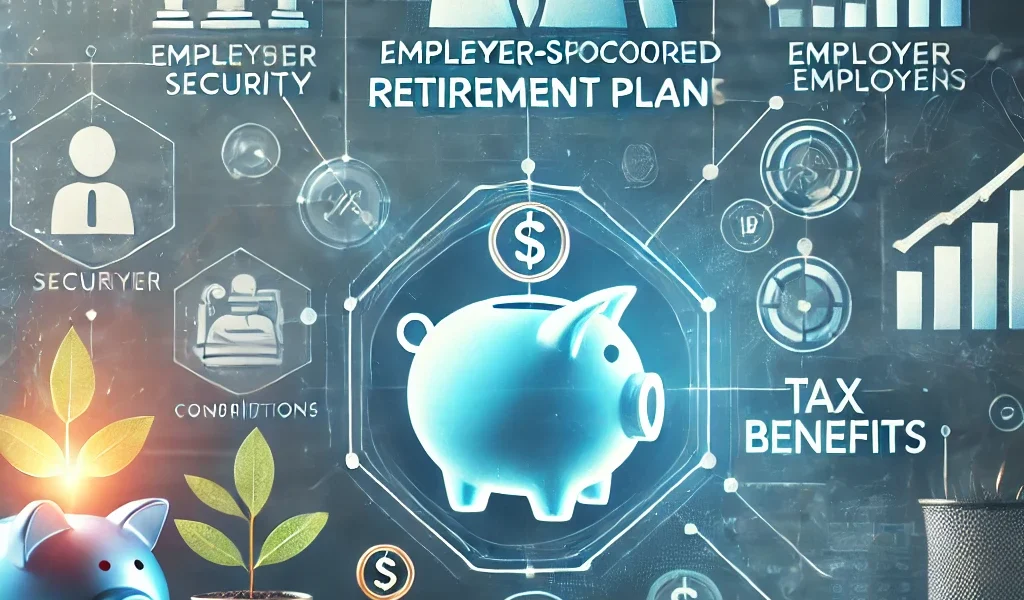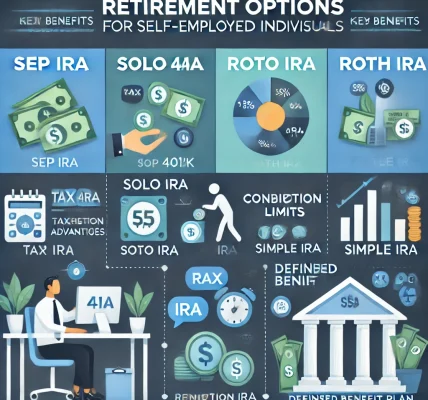Introduction
Planning for retirement is crucial, and employer-sponsored retirement plans offer a great way to secure your future. These plans help employees save and invest a portion of their income for retirement while benefiting from employer contributions and tax advantages.
In this blog, we’ll cover:
✔ What employer-sponsored retirement plans are
✔ Types of employer-sponsored plans
✔ Key benefits and tax advantages
✔ How to choose the right plan
✔ Common mistakes to avoid
By the end, you’ll have a clear understanding of how these plans work and how to maximize your retirement savings.
What Are Employer-Sponsored Retirement Plans?
Employer-sponsored retirement plans are savings programs that employers offer to help employees build their retirement funds. These plans come with tax benefits and sometimes employer contributions, making them an excellent way to grow your savings.
🔹 How they work:
- Employees contribute a portion of their salary to the plan.
- Employers may match contributions up to a certain percentage.
- Funds are invested in stocks, bonds, mutual funds, or other assets.
- Withdrawals are typically penalized if taken before retirement age.
Types of Employer-Sponsored Retirement Plans
There are several types of retirement plans employers may offer. Let’s explore the most common ones.
1️⃣ 401(k) Plan (Most Common in the U.S.)
A 401(k) plan allows employees to contribute a portion of their salary before taxes. Many employers match a percentage of employee contributions.
✔ Tax Benefits: Contributions are tax-deferred, meaning you pay taxes only when withdrawing.
✔ Employer Matching: Many companies offer free money through matching contributions.
✔ Investment Options: Employees can choose from various investment options (mutual funds, ETFs, etc.).
🚨 Note: If you withdraw before age 59½, you may face a 10% penalty plus income tax.
2️⃣ Roth 401(k) Plan
A Roth 401(k) is similar to a traditional 401(k), but contributions are made after taxes. This means:
✔ Withdrawals are tax-free in retirement.
✔ No required minimum distributions at age 73.
✔ Best for those expecting higher tax rates in retirement.
🚨 Downside: Since contributions are after-tax, it reduces your take-home pay now.
3️⃣ 403(b) Plan (For Nonprofits, Schools, and Government Workers)
A 403(b) plan works like a 401(k) but is available for teachers, hospital workers, and government employees.
✔ Tax Benefits: Contributions grow tax-free until withdrawal.
✔ Lower Fees: Often have lower administrative fees than 401(k) plans.
✔ Limited Investment Options: Typically offers mutual funds and annuities.
4️⃣ 457(b) Plan (For Government & Nonprofit Employees)
A 457(b) plan is for state and local government employees. It works like a 401(k) but with unique benefits:
✔ No penalty for early withdrawals (before retirement age).
✔ Flexible contribution limits.
✔ Deferred compensation option (delays taxable income).
🚨 Drawback: Fewer investment options than private-sector plans.
5️⃣ SIMPLE IRA & SEP IRA (For Small Businesses & Self-Employed)
✔ SIMPLE IRA: Used by small businesses with less than 100 employees. Employers must contribute.
✔ SEP IRA: Best for self-employed and small business owners. High contribution limits but only employer contributions allowed.
🚨 Downside: Fewer investment options compared to 401(k) plans.
Key Benefits of Employer-Sponsored Retirement Plans
✅ 1. Tax Advantages
- Traditional 401(k) & 403(b): Contributions reduce taxable income.
- Roth 401(k): Tax-free withdrawals in retirement.
- Employer contributions are tax-deductible for companies.
✅ 2. Employer Matching (Free Money!)
Many employers match your contributions up to a certain percentage. Example:
- If you earn $50,000 and contribute 5% ($2,500), and your employer matches 100%, you get an extra $2,500 free!
✅ 3. Automatic Savings & Growth
- Contributions come directly from your paycheck.
- Investments compound over time, growing significantly.
✅ 4. Investment Options
- Most plans offer stocks, bonds, ETFs, and mutual funds.
- You can choose investments based on risk tolerance and retirement goals.
✅ 5. Protection Under ERISA
The Employee Retirement Income Security Act (ERISA) protects your retirement savings from misuse and fraud.
How to Choose the Right Retirement Plan?
✔ Consider Your Employer’s Offering
Not all companies offer the same retirement plans. Check:
🔹 Does your employer offer a 401(k) or 403(b)?
🔹 Is there an employer match? If yes, contribute at least enough to get the full match.
✔ Look at Tax Implications
- If you expect lower tax rates in retirement, a traditional 401(k) is better.
- If you expect higher tax rates later, consider a Roth 401(k).
✔ Check the Investment Options
- Choose a diversified mix of stocks, bonds, and funds.
- Consider low-cost index funds to reduce fees.
✔ Evaluate Fees & Expenses
- Some funds charge high management fees (ER > 1%).
- Lower fees = more money for you in the long run.
Common Mistakes to Avoid
🚨 1. Not Taking Advantage of Employer Matching
- If your employer offers a match, contribute enough to get it – it’s free money!
🚨 2. Cashing Out Early
- Early withdrawals trigger taxes & penalties.
- Keep your funds invested for compound growth.
🚨 3. Not Reviewing Investment Choices
- Many employees forget to rebalance their portfolios.
- Adjust investments as you get closer to retirement.
🚨 4. Ignoring Fees
- Some mutual funds charge high fees – always check before investing.
Final Thoughts: Maximize Your Retirement Savings
Employer-sponsored retirement plans are one of the best ways to build wealth for the future. To maximize your savings:
✔ Start contributing as early as possible.
✔ Take full advantage of employer matching.
✔ Choose tax-efficient investment options.
✔ Avoid unnecessary withdrawals and high-fee investments.
By making smart decisions today, you can enjoy a financially secure retirement in the future.
👉 What type of employer-sponsored plan do you have? Let us know in the comments! 😊




